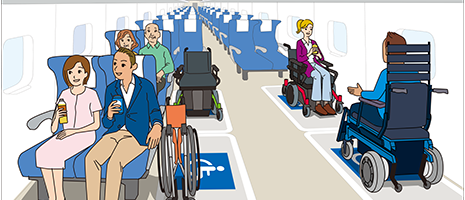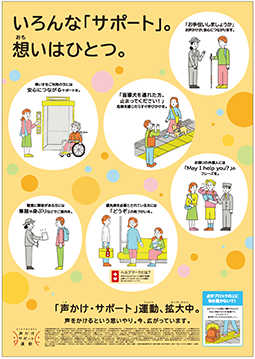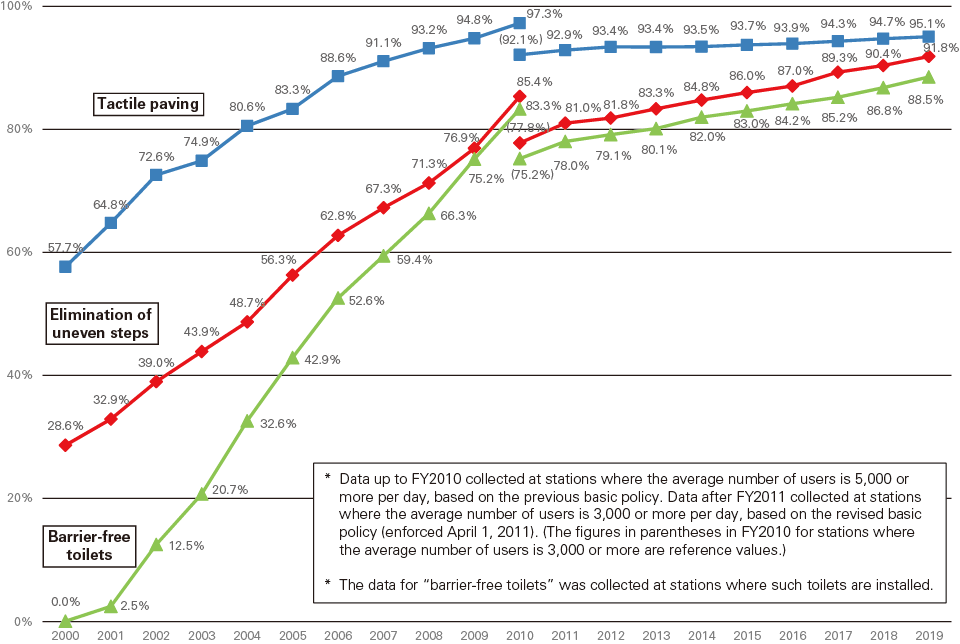INDEX
- English
- 日本語
- English
- 日本語

The layout for a Shinkansen train car with over 1,000 seats per train has been designed with the space for wheelchairs increased from two to six

The national government and railway operators have encouraged passengers to approach people who may need help with posters at stations
March 2021
Promoting the Barrier-free Design of Railway Facilities

Japan is currently promoting a barrier-free* environment in its public transport systems to facilitate the mobility of people including the elderly and those with disabilities. The goal is to realize an inclusive society where all people are able to move safely and with comfort.

The National Diet of Japan enacted the “New Barrier-free Law” in 2006 recognizing the need to promote the barrier-free design of buildings and public transportation systems. Under the law, national and local governments, and railway operators have promoted diverse, barrier-free design, including elevators to eliminate the need to use steps within stations, barrier-free toilets, and tactile paving (textured ground surface indicators to guide pedestrians who are visually impaired).
“According to the data as of the end of March 2020, barrier-free design is preferentially being introduced at 3,580 stations with 3,000 users or more a day on average, out of about 9,500 railway stations in Japan,” says Inoki Yuji, chief of the Engineering Planning Division of the Ministry of Land, Infrastructure, Transport and Tourism’s Railway Bureau. “Among these 3,580 stations, elevators, slopes and other facilities have been introduced at 91.8% of the stations. Tactile paving has been laid at 95.1% of the stations, and barrier-free toilets have been installed in 88.5% of the stations.”
In addition, platform screen doors have recently been installed to prevent passengers, especially the visually impaired, from falling. They had been installed at 858 stations as of the end of fiscal 2019. However, installation is time-consuming and costly. Therefore, the national government and railway operators have encouraged passengers to approach people with visual disabilities who may need help, rather than only to rely on station staff, using posters and train announcements. Other measures to prevent falls are also under discussion, such as using devices with ICT and sensing technology.
The new Basic Policy on Promotion of Transportation Facilitation was developed in December 2020, and it includes goals for the next five-year term beginning in 2021. It will continue to promote a barrier-free railway environment. The new goals aim to ensure that all stations with more than 2,000 but less than 3,000 users per day on average that are considered to be living-related facilities under local governments’ basic barrier-free concepts have barrier-free facilities where users are not bothered by stairs or steps. In addition, large stations will need to prepare multiple barrier-free routes (the routes for smooth movement between the door of the train and the exit of the station) for the safe, smooth movement of people with disabilities.
In December 2019, a study group was set up comprising members including railway operators and organizations for people with disabilities. They have continued to review measures to create barrier-free environments with the aim of ensuring that Japan’s high-speed rail service, the Shinkansen, is at the highest level in the world in terms of barrier-free design. Looking at spaces for wheelchair users on the current Shinkansen trains, there are only one or two wheelchair spaces per train. Groups of wheelchair users are unable to ride the train. Additionally, it is not currently possible to complete ticket purchases for wheelchair users online; people are only able to apply. They must go to a ticket counter at a station to complete and receive a ticket before taking the train. Organizations for people with disabilities have requested that a system that permits users to complete their purchase online be introduced. The study group is currently discussing the arrangement of a space for three to six wheelchairs and a free space that can be used by a group of wheelchair users or a user of a fully reclining wheelchair and a helper, and the introduction of an online system that permits users to complete the entire purchase process.
If consideration is given to the importance of the independence of the elderly and people with disabilities in the promotion of arrangements for environments that ensure smooth transportation, it will help everyone be more proactive and successful.
* Originally introduced as a term for housing construction, it means removal of the barriers people with disabilities face in their lives. Generally, it refers to elimination of physical barriers such as inconvenient steps and stairs. In a broader sense, it is used to mean the elimination of all barriers including social, institutional, and psychological barriers that complicate social engagement by people with disabilities.


